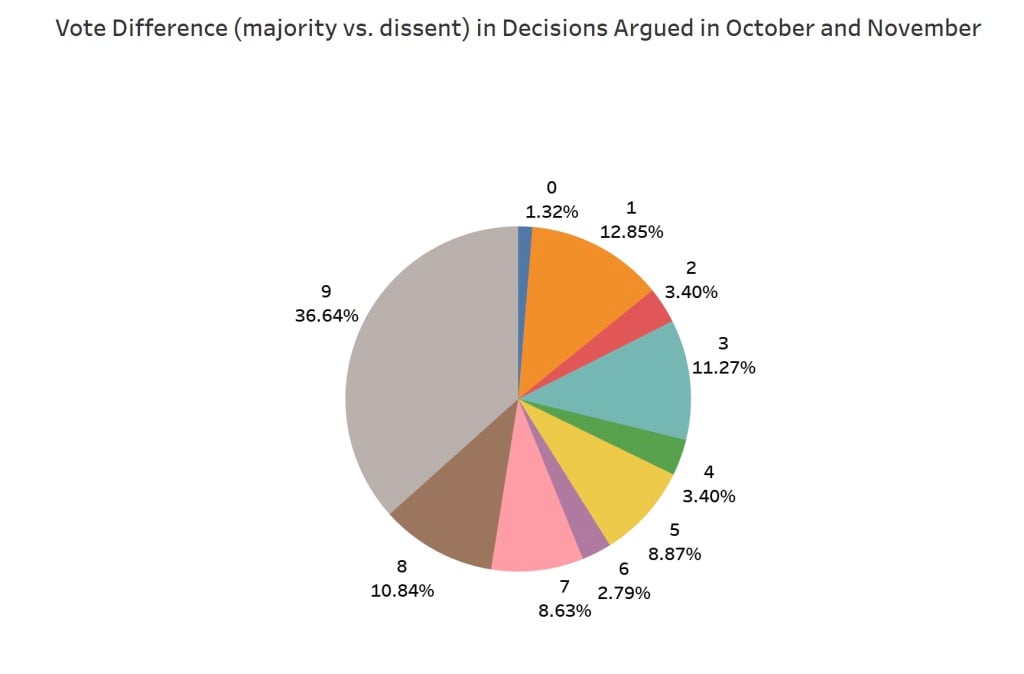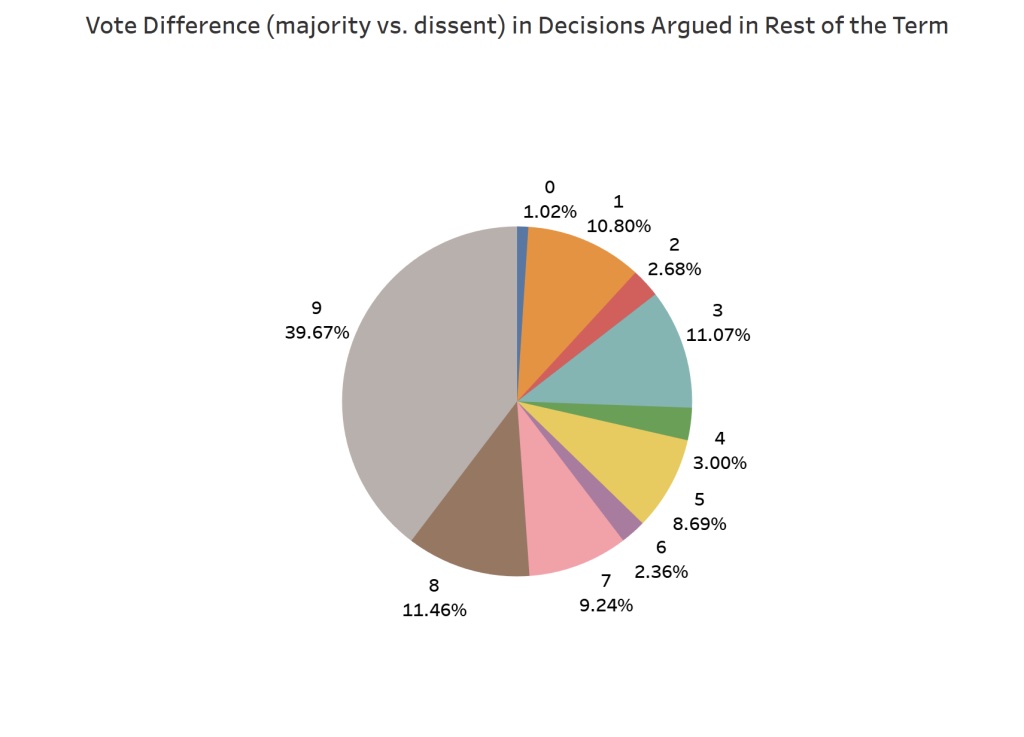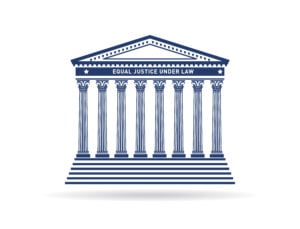The
Supreme
Court
is
known
to
leave
its
most
poignant
decisions
for
the
end
of
the
term.
The
end
of
last
term
included
among
other
decisions
the
release
of
Dobbs
(abortion),
Bruen
(gun
control),
and
WV
v.
EPA
(EPA’s
Clean
Air
Act
policy).
One
of
these
decisions,
Bruen,
was
argued
in
the
first
two
months
of
the
Court’s
oral
argument
calendar.
The
others
were
not.
In
fact,
an
argument
could
be
made
that
all
of
the
other
major
decisions
last
term
were
argued
after
the
November
sitting.
This
term
is
a
little
different.
Several
big
decisions
either
were
or
are
going
to
be
argued
in
the
first
two
months
of
the
Court’s
calendar
(note
that
this
analysis
begins
in
the
1917
term,
which
is
when
the
Court’s
calendar
began
to
start
in
October).
These
include
Merrill
v.
Milligan
examining
racial
gerrymandering
and
the
two
affirmative
action
cases
that
will
be
argued
in
the
November
sitting.
Most
cases
also
argued
in
the
early
months
of
the
Court’s
calendar
are
decided before
the
end
of
the
term.
Obviously
Bruen
was
an
exception
last
term.
If
the
argued
cases
in
the
Court’s
early
month
are
less
contentious,
then
perhaps
fewer
dissents
and
concurrences
should
be
filed
in
cases
argued
in
these
months.

The
graph
above
shows
that
certain
members
of
the
Court
and
particularly
Justice
Stevens
authored
many
separate
opinions
in
cases
argued
across
these
months.
The
drop
in
separate
opinions
authored
by
the
justices
for
such
arguments
though
drops
precipitously,
as
after
Justice
Douglas,
the
authors
with
the
next
most
such
opinions
authored
over
100
fewer
than
Stevens.
This
doesn’t
provide
evidence
of
across
the
board
separate
authorship
for
cases
argued
in
the
term’s
early
months,
but
it
does
show
the
oversized
participation
of
some
justices
(justices
with
fewer
than
50
separate
opinions
were
not
included
in
this
graph).
Next
we
can
look
at
the
decisions
argued
during
these
months
that
led
to
decisions
that
came
down
to
a
single
vote.
As
the
graph
below
shows,
most
of
these
opinions
were
authored
prior
to
the
current
Court
as
the
only
current
justices
on
the
list
are
Alito
and
Thomas
and
both
are
at
the
bottom
of
this
graph
that
has
a
cut
point
at
ten
decisions.

The
part
of
the
analysis
that
is
perhaps
most
striking
breaks
down
the
Court’s
vote
differences
in
decisions
argued
in
October
and
November
against
cases
argued
across
the
rest
of
the
term
(from
December
through
April).
I
controlled
for
differences
in
case
counts
by
using
percentages
for
the
vote
differences
rather
than
number
of
cases.
The
first
pie
chart
shows
the
vote
difference
fractions
in
cases
argued
in
the
Court’s
early
months.

The
early
term
argument
graph
shows
that
over
15%
of
these
cases
came
down
to
one
or
two
votes.
Contrastingly,
the
percentage
of
unanimous
decisions
(with
nine
member
Courts)
is
just
under
37%.
Surprisingly,
the
graph
for
percentage
of
outcomes
by
vote
decisions
for
arguments
running
from
December
through
April
shows
more
harmony.

The
percentage
of
cases
decided
by
one
or
two
votes
is
just
over
13%
for
this
set
of
arguments,
almost
2
percentage
points
less
than
in
cases
argued
in
terms’
early
months.
The
percentage
of
unanimous
decisions
is
3
percentage
points
higher
at
just
under
40%.
The
sheds
some
light
on
what
we
should
expect
to
come
from
cases
argued
at
the
beginning
of
terms.
Against
many
preconceptions
the
results
show
that
these
early
term
arguments
lead
to
more
contentious
decisions
than
cases
argued
later
in
terms.
We’ll
see
if
the
court’s
decisions
this
term,
especially
with
high-profile
arguments
in
the
October
and
November
sittings
comport
with
these
data
or
with
expectations
that
the
cases
argued
early
in
terms
should
lead
to
less
contentious
decisions.
Also
note
that
contentious
cases
for
the
current
Court
are
likely
going
to
be
those
with
a
vote
difference
of
three
or
fewer
votes
so
an
analysis
at
the
end
of
the
term
will
have
to
factor
in
this
change.
Historic
data
was
compiled
using
the US
Supreme
Court
Database.
Read
more
at
Empirical
SCOTUS….
Adam
Feldman
runs
the
litigation
consulting
company
Optimized
Legal
Solutions
LLC.
For
more
information
write
Adam
at adam@feldmannet.com. Find
him
on
Twitter: @AdamSFeldman.

